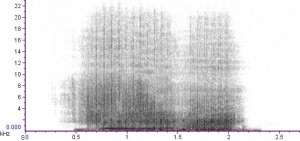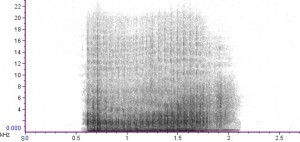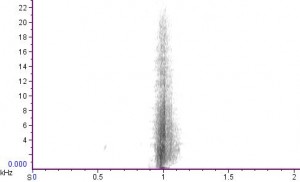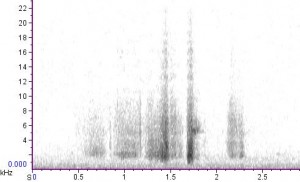They Taste Like Turpentine

Or so I’ve been told. Supposedly the only way that Spruce Grouse can get away with being so remarkably “stupid” is the fact that since they eat spruce needles they taste absolutely vile, vaguely reminiscent of turpentine. Since, obviously, I haven’t actually tried Spruce Grouse myself I can’t comment on what they actually taste like, but it certainly sounds like as good an explanation as any… However, despite their not tasting very good this is still a highly sought-after species, with a well developed reputation as a hard to find bird. Here is my take on how you can find one…
Depending on who you ask, how to actually find a Spruce Grouse is a matter of debate. Some people say it’s easiest in the winter, when deep snow forces birds to the edge of the road. Others may say it’s in the later summer, when females herd their young through the spruce-fir. If you ask me, though, I would say that it’s in the early spring, when the muffled wingbeats of displaying males echo softly through the forest.
First off, though, I should correct a common misconception about Spruce Grouse displays. They do NOT include extremely low pitched hooting, as has been reported in many sources (e.g., Sibley). This misconception apparently has its roots in and article by Greenwalt (1968), and this error has been echoed through many field guides until recently. The displays of Spruce Grouse (the males at least) are entirely non-vocal, and the low pitched vocalizations referred to in most sources apparently are in reference to Dusky or Sooty Grouse.
I should also note that all the displays I write about below are in reference to the nominate subspecies of Spruce Grouse. The taxon found in the northwestern part of the lower 48 and adjacent Canada (“Franklin’s” Grouse) has a different display, and one I am not familiar with.
The main display of male Spruce Grouse (and the loudest, and thus easiest to hear from a distance) is simply the sounds of the wings whirring as it flies from a perch about 15 feet in a tree to the ground, and then back up to the tree. The specifics of the wing noise varies, though, between the descent and the ascent: during descent the bird flies normally, until it nears the ground, when it suddenly rears up nearly vertically in the air and the pace of the wingbeats picks up noticeably. During the ascent the wingbeats are more powerful and faster, but even in pitch throughout the flight.
While neither of these wing noises are especially loud, in the early spring boreal woodland (where there tends to be very little noise) it can carry for quite a distance and be a good way to find them.


Once you’ve located the displaying grouse, if you watch it long enough you may well notice some other, quieter and more subtle displays. One that was frequently given by a bird I observed for a couple of hours in Maine consisted of the bird lifting both its wings about a quarter way to horizontal and then beating them against the sides of its body, producing a muffled but quite audible “thump”. This sound is apparently not described in BNA, but seems to be a quieter version of the two loud “gunshot-like” thumps of the display of “Franklin’s” Sprcue Grouse.

The other display that I observed from Spruce Grouse in Maine is what BNA calls the “tail-whoosh”, where the bird opens its tail and closes it rapidly, producing a slightly metallic swishing noise. It is also surprisingly loud for a sound being given by just the tail of an otherwise stationary bird. Compared to the flight displays and wing thumps, the tail-whoosh is a rarely given noise, at least during my observations – I heard perhaps a half-dozen total during two hours.

4 thoughts on “They Taste Like Turpentine”
Do Franklin’s Grouse also taste different?
The Spruce Grouse also makes a subtle whirring sound or purring. I observed a male running circles around another male. As he ran on the ground a very soft whirring sound emanated from his wings. see my blog entry from this spring at http://visitcranelake.com/blog/?p=1589
Hi – I remember hearing Franklin’s Grouse in the Okanagan in British Columbia some years back. I was surprised by the display which was a double wing clap as it was quite loud and striking. I could not see the bird, it was probably pre-dawn when it was doing it, but it was a pretty distinctive sound. It certainly is different from canadensis Spruce Grouse.
Comments are closed.